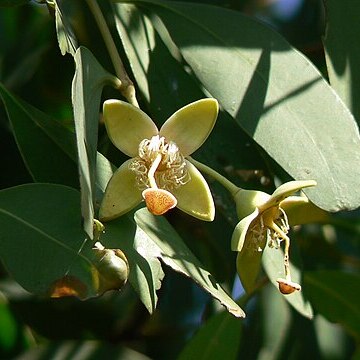Columnar trees to 15(-20) m tall. Pneumatophores to 1.5 m; ultimate branchlets pendulous. Petiole 5-10 mm; leaf blade narrowly elliptic to lanceolate, gradually tapering toward apex, 5-13 × 1.5-4 cm, base attenuate, apex obtuse. Flowers 4(-6)-merous in a 3-7-flowered cyme. Floral tube 1.5-2.5 cm at anthesis, smooth; sepals green, slightly curving around base of fruit. Petals absent. Staminal filaments white. Stigma peltate, to 7 mm wide. Fruit 1-2 × 2-2.5 cm in diam. Seeds typically U-shaped or falcate, 8-9.5 mm. Fl. May-Dec, fr. Aug-Apr.
A tree. It is willow like. It grows 15 m tall. It has aerial roots 1.5 m long. The end branches hand down. The leaves are narrowly oval and taper to the tip. They are 5-13 cm long by 2-4 cm wide. The flowers are in groups of 3-7. They do not have petals. The fruit are 1-2 cm long by 2-3 cm wide. The seeds are U shaped.


